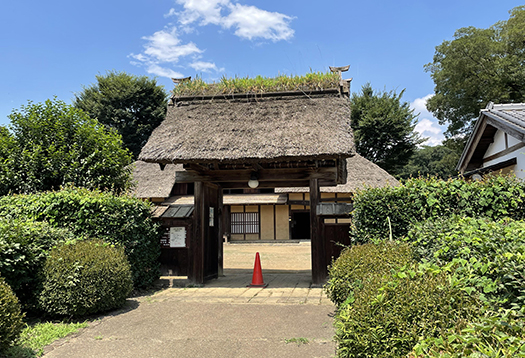


日本の民家を探訪して現代北海道住宅の文化ルーツを求める。
至って当然の志向性だと思うのですが、
しかし実際に探訪してみると「座敷・床の間・縁側」という
日本住宅3点セットを北海道の家はほとんど無視していることを痛感。
たぶんこのことは、日本人の生活様式がこの150年間で大変貌して
生活文化の「世界共通化」圧力が圧倒的に進行し
日本人が大切にしてきた「家意識」が希薄化したことと関わっている。
武家政権にまで至る時代では家というのは、
個人をはるかに超えた価値感であって、いわば法人格としての家格意識が
もっとも大切な価値感とされてきたことと深くつながっている。
武家は家の存続維持のために個人はいのちも捧げるものとされてきた。
戦国期の戦争で武士たちが命のやり取りをしたのは、
自分一個が死んでも、家系・家格が存続し繁栄することが無上の目的だった。
もっと言えば「武士道とは死ぬこととみつけたり」は事実だったのだ。
そのような価値感を建築的に象徴表現するのが座敷や床の間だった。
畳という日本オリジナルの床材を敷き詰めての座生活。
背筋がピンと立つという精神性重視の社会規範を育んだということか。
あるいは門などもそうした「格式材」として機能したのだろうか?

こういう家の表現空間が北海道では急激に廃れていった。
わたしなどは古い価値感の残滓が多少は残っている世代なので
寝室としては、当初畳の敷かれた部屋を用意した。
ブロック外断熱の家なので床の間のような空間もなく、
縁側のような中間領域は寒冷地住宅としてハナからムリだった。
そしてその畳寝室も数回のリフォームで消え去り今はベッド生活。
とくに戦後社会以降、世界共通の現代住生活スタイルに染まった。
知る限りこの傾向は、日本社会で普遍的に発生している。
居間にはテレビが置かれソファでくつろぎ、食事はダイニングとキッチンが
折衷された場所で椅子テーブルで取り、食事後は各自の洋室で
家族バラバラの「個人主義」として過ごす。
テレビが鎮座しているけれど、たまに好みのあうプロ野球観戦などで
家族一緒に楽しむこともある程度なのではないか。
和室は現代であるとすれば、リビングに隣接する畳空間エリアというように
かろうじて存在しているというのが一般的。
しかし日本人は本当に和室、畳、床の間などを忘却していくだろうか。
人口減少は世界的な趨勢だと言われるが、それは個人主義進化と共振現象と思う。
変化は不変、といわれるように現代の傾向がそのまま続くとも思えない。
写真のような空間性がまた復権する可能性は、さて・・・。
English version⬇
Zashiki, Tokonoma, Engawa and Hokkaido "Akagi-type" Sericultural Minka-6
From family consciousness to individualism. A device for imprinting a sense of home. It disappeared early in Hokkaido, the world's leading standard of living, but now...
Seeking the cultural roots of modern Hokkaido housing by exploring Japanese minka houses.
I think this is a perfectly natural orientation.
However, when I actually visited the houses, I realized that most of the houses in Hokkaido
However, when I actually visited the houses, I realized that most of the houses in Hokkaido ignore the three Japanese house sets, "Zashiki, Tokonoma, and Engawa.
Perhaps this is due to the fact that the Japanese lifestyle has been drastically transformed over the past 150 years, and the pressure of "universalization" of lifestyle culture has been increasing.
The pressure for "universalization" of lifestyle culture has become overwhelming, and
The "sense of home" that the Japanese have long cherished has become increasingly diluted.
In the period leading up to the samurai regime, the sense of home
The sense of family as a juridical entity, so to speak, was considered the most important value.
This is deeply connected to the fact that the sense of family status as a juridical entity was considered the most important value.
The samurai were expected to sacrifice their lives in order to maintain the family's existence.
During the wars of the Warring States period, warriors exchanged their lives for the sake of the family's survival.
The ultimate goal was to ensure the survival and prosperity of the family lineage and family status even after the death of one individual.
In other words, it was a fact that "Bushido is found in death.
The architectural symbolic expression of such values was the tatami room or alcove.
The tatami mats, Japan's original flooring material, were laid out for the sitting room lifestyle.
This may mean that the social norm of standing up straight was nurtured, placing importance on the spirituality of the people.
Or perhaps the gates also functioned as such "prestigious materials"?
This kind of expressive space in the house has rapidly fallen into disuse in Hokkaido.
I, for example, am of a generation that still retains some residuals of the old sense of values.
For the bedroom, I initially prepared a room with tatami mats.
The house is insulated outside with block insulation, so there is no space like an alcove.
The house is insulated with block insulation, so there is no space like an alcove, and an intermediate area like a porch was impossible for a house built in a cold region.
The tatami bedroom disappeared after several remodeling projects, and now we live in bed.
Especially since the postwar period, the Japanese lifestyle has been tainted with the modern lifestyle common all over the world.
As far as I know, this trend has occurred universally in Japanese society.
In the living room, people relax on a sofa with a TV, and eat at a table with chairs in a place where the dining room and kitchen are blended together.
After dinner, each family member goes to his or her own Western-style room.
After dinner, the family members spend their time in their own Western-style rooms as "individualists.
There is a television set, but the family only occasionally enjoys watching a professional baseball game together.
The TV is on, but the family may enjoy watching a favorite professional baseball game together once in a while.
In the modern era, a Japanese-style room is generally considered to barely exist as a tatami area adjacent to the living room.
However, Japanese people really do have Japanese-style rooms and tatami rooms.
However, will Japanese people really forget about Japanese-style rooms, tatami mats, and tokonoma (alcove)?
Population decline is said to be a global trend, but I think it is a phenomenon that resonates with the evolution of individualism.
As it is said that change is immutable, I do not believe that the current trend will continue as it is.
What about the possibility of a return to the spatiality of photography?










